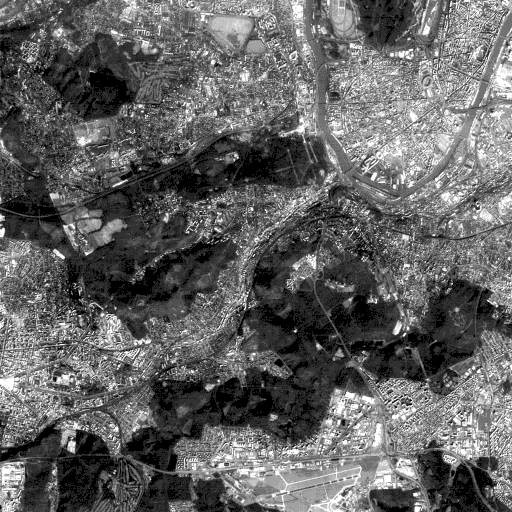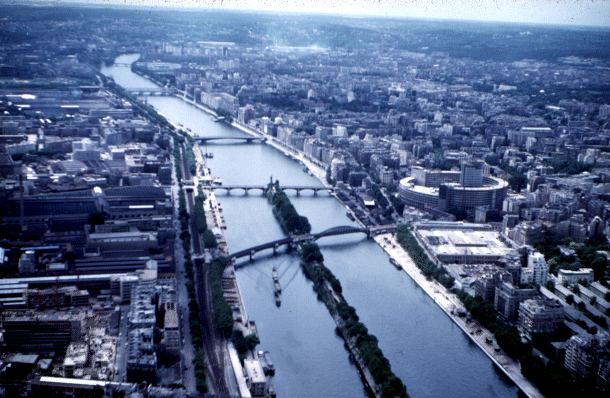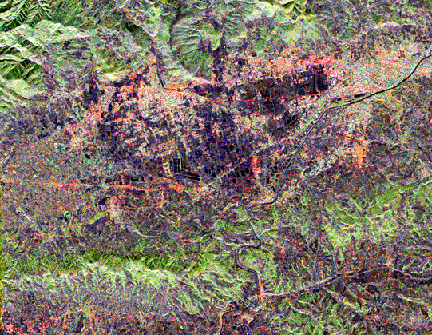Especially prominent is the strongly meandering (bending) River Seine, joined by the Oise (west) and Marne (east) rivers of World War I fame. The large wooded area within a loop near the western limits of denser population is the Foret de St. Germaine. Central Paris, with its many famed monuments and buildings, lies just to the west of the juncture of the Marne with the Seine. Note that by April many of the outlying farms have actively growing crops.
Look now at a small part of this great metropolis as seen at 10 m resolution by the panchromatic sensor on SPOT.

The upper right corner of the section displayed is just about 1.2 km (0.75 miles) southwest of the Eiffel Tower - the symbol of this city. The panorama seen in the next picture is a view from this tower looking generally southwest towards the SPOT scene.

To place this 10 km (6.2 mile) wide image within metropolitan Paris, note the position of the white X marker in the Paris subscene above which locates the approximate center of the image. The south end of a great meander loop of the Seine River that passes across this section of the city is prominent in the image. Within the loop is a community known as Boulogne Billancourt; the southern end of the Bois de Boulogne, the city's largest park, appears as a dark area at the top right. Note the nearby Longchamp and Aueteil race courses. The immediate district to the west is the Hauts de Seine (suggesting low hills). The feature that looks like a distorted pentagon is the Hippodrome de St. Cloud and to its left is the Fôret de la Malmaison, a forested tract just south of Rueil Malmaison. Next to it is an area resembling a golf course that actually is a U.S. Military Cemetery for the fallen of World War I.
The major road crossing this image center is a large expressway - the AutoRoute de l'Ouest (A13) to Rouen and then Le Havre on the English Channel. Adjacent is the Parc de St. Cloud, within the inner suburb by that name. The lower half of the image is bottomed by the highway A86 just above the Villacoublay airport. Route 10 winds northeast between the two irregular wooded areas bounded by Meudon on the east and the center of Versailles on the west. Route 118 passes northward through Velizy-Villacoubay, joining 10 near the Seine loop.
The last stop on this urban tour is another, but smaller (about
a half million people) European city: This one is Firenza or Florence,
nestled in the Tuscany hills several hundred kilometers north
of Rome in Italy. Florence (the writer's favorite spot in Europe)
is known as the cradle of the Renaissance, the home of Michelangelo,
and a treasure house of art and culture. Here it is in a radar
color composite (LHH = red; LHV = green; CHV = blue; see Section
8 for an explanation of these bands and polarization modes) made
by the SIR-C radar from the Space Shuttle on April 14, 1994:

This view is at an odd orientation but north is towards the top.
The River Arno passes through the image as a narrow, winding black
band. That same river runs through this ground scene taken from
the Piazza Michelangelo on the south side of the city. The famed
Ponte Vecchio (a 15th century covered bridge with shops and stalls
still in business today) is one landmark; the tower in the town
hall at the Piazza Vecchio lies near the photo center and part
of the Duomo (cathedral) with Giotto's Tower is at the right edge.
In this radar composite much of the city stands out in very dark gray to black tones, signifying low radar beam returns. The reason for this is not clear as most metropolitan areas tend to have lighter tones owing to building corner reflections and other factors (parts of the city here display this characteristic). A hallmark of Florence - and much of the dwellings in Italy - is the red tile roofing evident in the ground photo. Perhaps the properties of the tile give rise to efficient specular dispersion (minimal backscatter) of the radar signal. The large, dark partial "V" in the central city is the railroad station which has a flat roof.
Code 935, Goddard Space Flight Center, NASA
Written by: Nicholas M. Short, Sr. email: nmshort@epix.net
and
Jon Robinson email: Jon.W.Robinson.1@gsfc.nasa.gov
Webmaster: Bill Dickinson Jr. email: rstwebmaster@gsti.com
Web Production: Christiane Robinson, Terri Ho and Nannette Fekete
Updated: 1999.03.15.